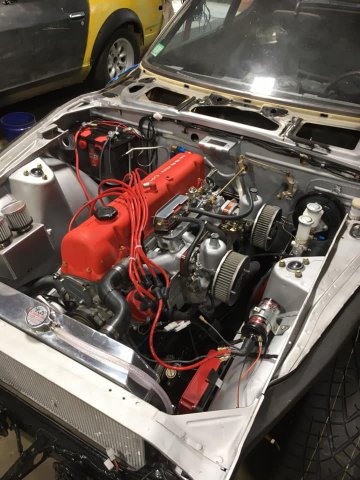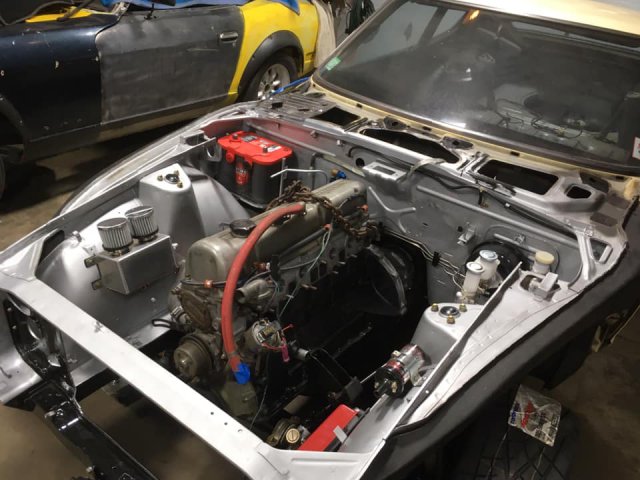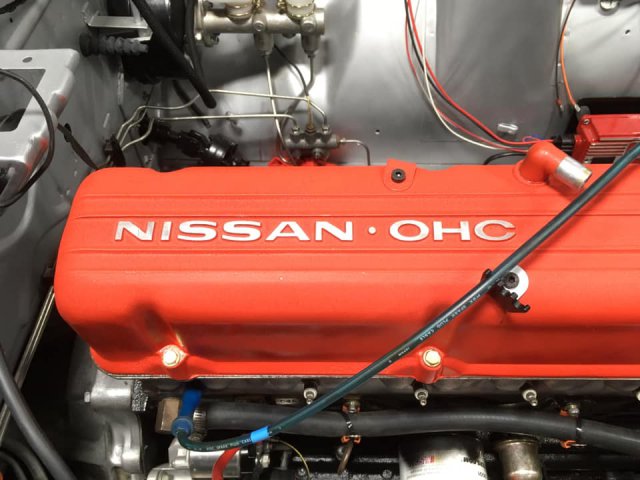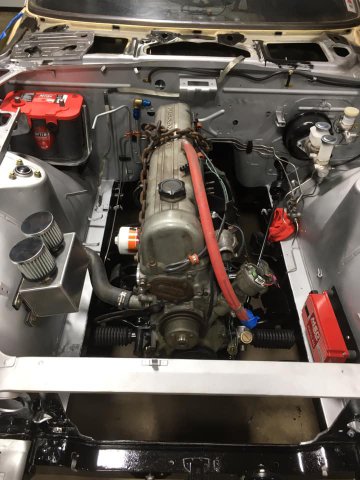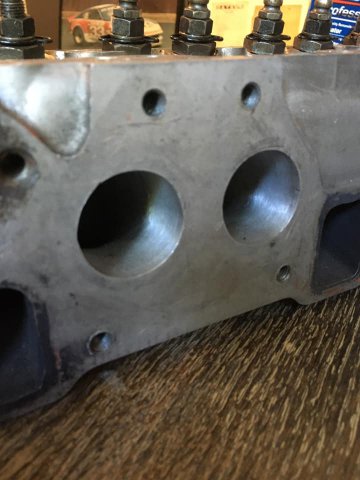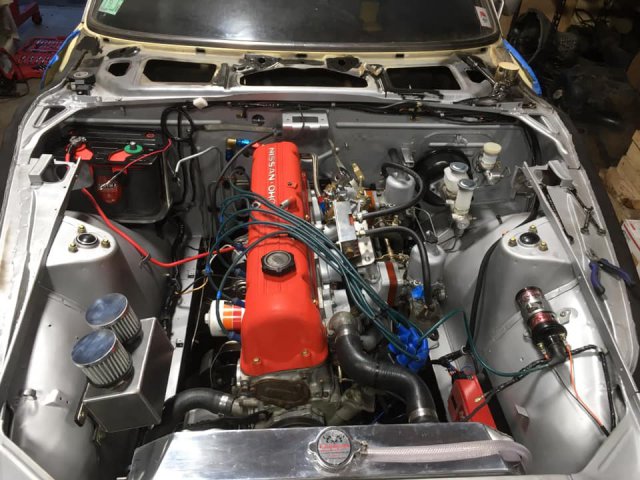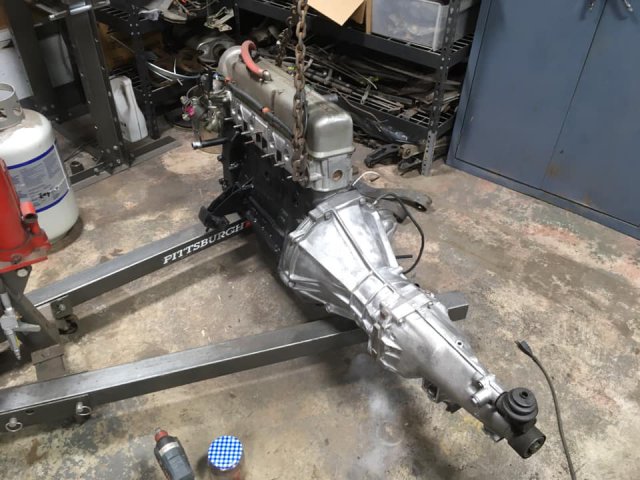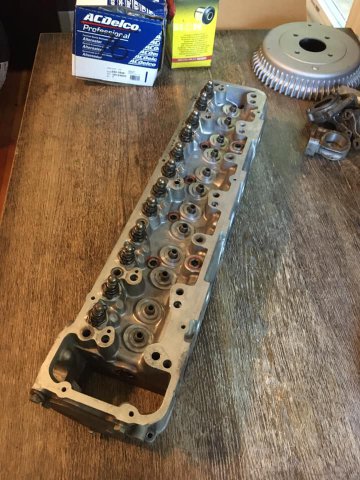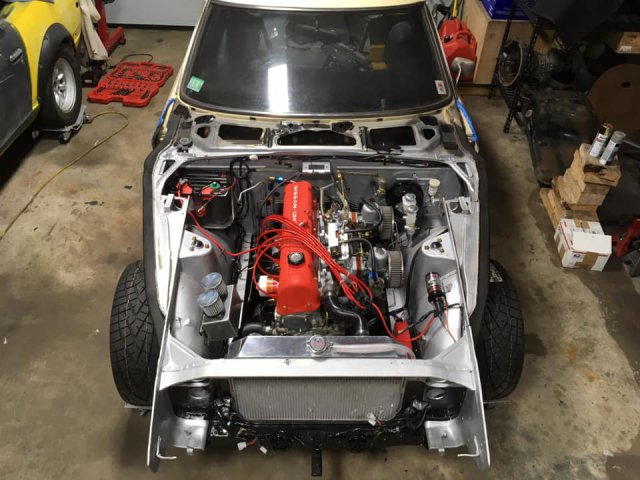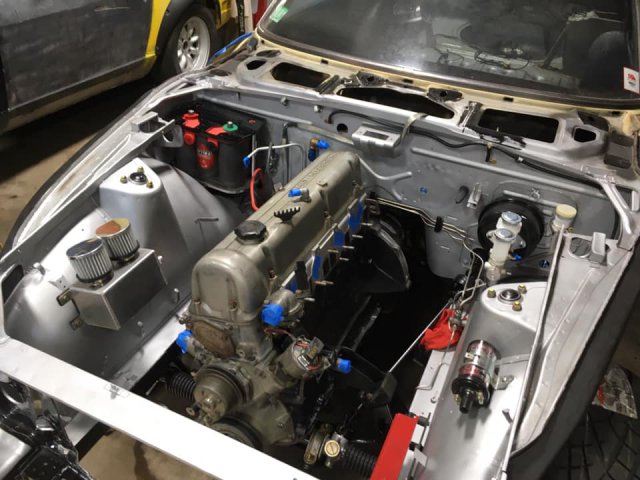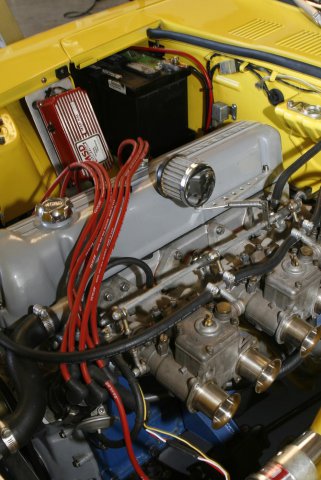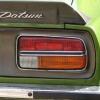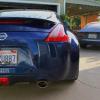Search the Community
Showing results for 'petronix'.
-
I am going to upgrade my stock engine with a Petronix distributer kit and add the MSD-6 box with the Petronixs coil. Has anyone hear used this combo and where you pleased with it? I am on a tight budget so I hate to spend the bucks and not get what I expect! I did add a MSD6 box to a Corvette and was impressed with the improved starting and power. Will the electronic ignition burn up if I leave the key on and the engine is not running? Can anyone shed some light on that aspect of the ignition?
-
Last weekend I went on a winery tour with fellow TZCCVA members out in the Charlottevsille area of Virginia. Anyway, it was an uneventful trip (except for the torrential rain and flooding caused by that awful cold front) until I was heading home. Running along at 75-80 on I64 I suddenly hit a rpm ceiling of about 4000. I couldn't accelerate over 60 mph. I pulled off the road to check for scary stuff like fuel leaks but saw nothing wrong. The remaining 100 mile trip home was met with power then no power back and forth until I got home. My immediate suspicions is the 25 y.o. Allison ignition is starting to heat fail so I ponied up for a Petronix 1761 and new 40611 3.0 40k volt coil. I'll try to get this installed this weekend. The real reason for posting this to let everyone know that www.streetsideauto.com has the best deal going for the Petronix kit. The igniter ($68.98) and coil ($32.99) were $101.97 shipped! If you're in the market for these parts you'll not find a better deal.
-
I need some help diagnosing a no-start condition on a friends Z. Last week, his car wouldn’t start after running fine for years, and it turned out there was no spark. He was running a 240Z distributor, MSD 6AL, and an old (early 90’s) Allison XR-700 optical ignition. I narrowed it down to the XR-700, and last night I replaced that with a Pertronix ignitor. We have spark again, but it still refuses to start. It came close a few times, but no go. The Pertronix is fixed in place in the distributor, but the XR-700 optical pickup was adjustable, which could have an impact on timing. I was wondering if perhaps at some point the distributor timing may have been adjusted to compensate for the optical pickup location some how not being correct? Now with it back to a stock like condition, could the distributor timing be too far off? How far off would the timing have to be to prevent the car from starting? There are timing marks on the distributor itself. Is there an initial position that the distributor can be set to where it is most likely to start? BTW, the distributor has NOT been removed. The only other possibility that I can think of is that the engine is flooded (triple Webbers). We were cranking it a lot the week before trying to diagnose the problem. But it sat for a week before we tried again, and we didn’t crank it much last night. However, it did come closest to firing after we took all the plugs out and let the engine sit for about 15 minutes. My friend is getting understandably frustrated and wants to get the car towed to a garage, but it seems like it should be a simple issue and easy to fix. Unfortunately, all of my experience is with my SDS EFI distributor-less system. I went with that so I wouldn’t have to deal with issues like this! Any help would be greatly appreciated!!! Nigel '73 240ZT
-
The engine is an L24 2.4L bored 1mm oversize. I have Nissan comp 9mm rods in it. The pistons are flat tops and the entire engine was blueprinted and balanced within a milligram. The head is a rebello racing E-31. I have plans to build out the L28 and install my secret sauce E-31 machined and worked by a long time Bob Sharp mechanic. Im running MSA 6-1 headers and 2.5" exhaust with a turbo muffler. The ignition is powered by MSD digital 6AL, and the distributor was a stock unit with petronix ignitor installed, but the signal was too weak for the digital 6AL box so I installed the Mallory Unilite. Custom ground Cam by ISKY. Nissan comp valves and springs. The transmission is a zx5spd. The carbs are custom bored and I have custom jets and needles made for better performance at higher RPM.
-
As Softopz and I have both mentioned. Use the MSExtra hardware guide. It has the most up to date information and methods. I also sent you the relevant sections to look at for wiring. That does NOT include section 5.2.2. Section 5.2.2 is for a VR sensor. You do not have a VR sensor. You have an Dual Optical Crank Angle Sensor . As stated in section 5.2.8 of the MSextra hardware manual, the Nissan, Mitsubishi and GM Optispark systems have to be built in a specific manner. And that manner is in section 5.2.3 of the MSextra manual. Not the Diy site. Use section 5.2.3 . The Nissan Optical CAS also must have a +12 volt power feed. It's not a simple LED like a Petronix or Mallory Unilite. Lots of complicated circuitry in the Nissan CAS and it requires +12 volt power input. The part that must be understood, is that an an Optical sensor or a Hall sensor can be wired through the Opt/in circuit or the VR conditioner circuit. Either method will work. The old method was Opt/in. But the VR conditioner circuit provides a clearer signal and is provides adjustable noise filtering which the Opt/in circuit does not. That's why it is recommended in the MSExtra manual. But the use of the VR conditioner was only available with the software revisions in Firmware versions 3.2.1 and later. That's why we keep saying to use the MSExtra 3.4.2 Hardware manual. Tuner Studio will work fine with your current settings and the Tune I sent. Once the missing components are added and things are wired correctly.... The term VR conditioner is badly named. It causes confusion as people think that it is only for VR sensors. That's not true. It can be used with any sensor. Hall, Optical LED, VR or points. A better named would be just a generic: " Signal " conditioner IMHO. Your mainboard ( and Relay Board ) are wired wrong and have missing components. Install the Bip 373. Move JS10 wire to an unused output ( Maybe SPR3 or SPR 4 ) It looks like SPR1 and SPR2 are populated. Probably for PWM idle control. Hussein can advise better on that than me. You need. 1: BIP373 coil driver installed in Q16. Jumpers configured and jumper wire for JS10 relocated. 2: + 12 volt supply to the Nissan CAS. Right now we aren't sure what it's getting. 3: +12 volt supply in Run and Crank position ( Ignition switch ) to your coil. Right now it has nothing. That's not gonna work. Remember that the MS ECU controls most devices by GROUNDING. It doe not supply +12 voltage to injectors, ignition coil, fuel pump, IAC solenoids etc. Anything with a high current demand has to be supply +12 volts through a dedicated circuit or high current relays. Hope this helps clear the muddy waters...
-

Replaced bad XR-700 with Petronix - Still wont start!
Nigel replied to Nigel's topic in Trouble Shooting / General Engine
I did figure it out. I initially wasn't aware that there are two timing adjustments possible on the distributor. As I suspected, whomever had installed the XR-700 had positioned it without any consideration for the stock timing marks on the distributor, so that both the timing adjustments on the distributor had to be pretty much maxed out to get 10 degrees of advance. The Petronix positioning is fixed to match the stock points. After I learned about how to do a static timing check, I discovered that with the Petronix installed, the timing was now ahead by something like 20 deg. AFTER TDC! So, no wonder it wouldn't run. I got it part way back with the adjustment directly under the distributor, but it wasn't until I discovered that the distributor could be rotated even further at the other adjustment point closer to the timing cover that I got the timing back to where it should be. She fired right up after that. Learning how to do a static timing check turned out to be instrumental in diagnosing this problem. I was even able to set the timing almost dead on to 10 deg. before TDC without a timing light. Nigel -
Asking 2100 for all. Distributor has petronix installed.
-
This is my first experience with a turbo charged engine and the L28 and i was really unsure as to what to expect as a point of reference the tuned 350 Z's were producing 304 to 307 hp. 71' 240 Z, L28 280ZX turbo 5 speed drivetrain, with a Holley 4150 blowthrough , intercooled hybrid turbo 10lbs of boost with an internal wastegate. MSD 6 BTM with a 5,500 rpm limiter, locked distributor, aeromotive boost ref fuel regulator. petronix ignition. 92 octane gas. Had the car for a year, bought as an abandoned project after being in storage for many years. This was a test run to establish some sort of baseline figure, unfortunately the clutch was slipping badly under full load (smoke coming out of bellhousing, that's what happens when you teach a teenager to drive stick and SCCA autocross). It was a really hot day, my air intake is currently behind the radiator, and i had removed the turbo blanket to adjust wastegate linkage. Engine and oil temp 180. Engine runs rich at 11 to 1 off boost and 14 to 1 under full boost.
-
Alright, so.. A few months back, I purchased me first 1973 240z with an unknown amount of miles on it from a younger Asian guy who had the car sitting in a garage for the last year. Prior to that, an older gentlemen had the car and did lots of work on the engine, body, and interior. When I purchased the Z, it had next to no power so as soon as I got her back home I times the engine to 10-15 degrees and cleaned out/recalibrated the carbs. After that, pure power. It ran great for about a month until one morning I tried to start it and it just wouldn't run like normal. To get it to start now, I have to choke it all the way and occasionally have to put starter fluid in the carb. When it does start, it revs high for a few seconds then comes back down and kills over. Since then, I've checked the engine pressure, rechecked the timing and carbs, the carb needle, the float and float needle, replaced the ignition and distributor with a Petronix system, checked fuel pressure and fuel lines, replaced the vacuum lines, took off the valve cover and checked to see if everything is in order. I have no idea what to look for next, and have looked through every thread and manual I can find. Any help would be greatly appreciated, as for im completely lost at this point.
-
Thanks for the replies! The night before the engine problems, I filled the tank with premium gas. The tank was about 25% full before hand. Do you think it's worth draining the tank? I've only recently began learning about cars, where and what should I look for with the starting circuit? Does that have to do with the ignition system? I've replaced the distributor/coil with a Petronix electronic system. I've also taken apart most of the carburetor, including the jets that adjust the lean/rich mixture. I've replaced the vacuum lines, because at one point there was a small leak. I'm going to continue working on the 240Z later today, and hopefully I'll figure something out. I've called a local mechanic whom knows a lot about Z's and he suggested re-checking engine pressure, as well as taking off the valve cover off and inspecting the works. Any more ideas would be greatly appreciated, I really do miss driving the Z.... Thanks a lot for the help!
-
I thought Id share this with everyone. Im pissed to say the least. I bought a Mallory Unilite and tried to install today. Took all day because it wasnt getting spark. Put in the old point distributor and it fired right up. I ordered the Petronix upgrade so I hope that will be easy enough. Anyways, heres what I wrote the company: "Hello, I have recieved the distributor but it was defective. The ignitor seemed to be defective and would not produce a spark. This is what my mechanic confirmed. We reinstalled the old distributor and all was well. PLease let me know where to send this back to for a refund. Thanks... Terry Baldwin" And his reply: "There is not a refund and what likely happened is that somehow during install the module was damaged. What we can do is replace the module under Mallory's warranty. You would need to remove the module, send it in for testing/replacement. There are two screws that hold the module in place, and then just use a small screwdriver or other device to retract the barbs (one for each wire) that go into the nylon harness connector plug. Light push each wire into the plug, use the screwdriver in the opposite side (connector site) and gently push against the barb and then the wire(s) can be pulled out of the plug. You may also contact Mallory regarding warranty at (216) 688-8300 Best Regards, Sales & Technical Support Staff Century Performance Center, Inc. http://www.centuryperformance.com ph. (775) 746-4887 fax (702) 953-0705 I told them I wasnt going to start disassebmling this thing and cause more damage so I told them I would send back the entire distributor for repair. I am waiting on thier reply. Im starting to hate Mallory cause I know itll be a long time before I get it back. I hope the Petronix works better and I hope its not to hard to hook up a MSD 6A to it. Maybe someone who has done it can chime in. I was wondering where the two wires will exit when installing since there doesnt appear to be a hole in the housing to pull them through. Thanks for reading!!! Terry
-
20 MPG from triples? My set-up works fine 42DCOE, mechanical advance distributor, MSD 6AL, Petronix, but 20 MPG ... not even close. I think I'm getting like 8 MPG at the track. Picture shows OEM distributor and vacuum advance. That set-up, did not work well. Classic bog at 1500 to 1800 RPM. In hindsight, I think timing advance had a great deal to do with it and not just the mechanical advance. We also took advice from Jeff Winters on the air corrector, idle jets, and other parameters. Even changing the plugs helped. So I can't say all my results were from the mechanical advance alone.
-
In the process of trying to resurrect a friends 1973 240Z that has been sitting for at least five years. I have done all the usual things to get it going again. The car now runs but only when the key is in the start position with the starter energized. As soon as the key is moved to the run position the engine immediately dies. I've eliminated all the usual suspects and changed out all the ignition parts, distributor cap, rotor, wires, etc. and even went to Petronix electronic ignition. After all those changes I still have the same problem. I'm now wondering if the ignition switch is the problem and thinking maybe I can hot wire around the switch to eliminate that possibility. Help me here. Am I forgetting something or overlooking the obvious???
-
I also just installed the Delta 270-2 that Xnke mentioned. My idle is set at about 900 with a nice subtle lope. The overall power is less than I was hoping for but I didn't want to replace springs/retainers. It pulls okay off the line and really wakes up at +3000 rpms. The biggest issue was relearning the car with the power band moved further up. I now find myself tooling along in the 3000-4000 rpm range more often. It did occur to me to advance the cam a few degrees for better off-idle performance but I'm sorta happy right now. The old lash pads (run with the damaged Crane 272) I'm using mic'd at .165" and work perfect with this regrind. I did use new rockers so you might have to bump up the lash pads to .170 or .180 with reground rockers. On a side note, my distributor is stock with a petronix pick-up. Timing is set at 12* static and I'm using the vacuum advance. Any suggestions regarding changes here to possibly get a little better throttle response leaving a stop light?
-
hey guys, i was wondering if you could help me possibly point out what happened to my 240z the other night as it would not start back up and i had to get it towed. heres some details on the car: 73 240z 4spd running round top su carbs have not done final tune, running a little rich, fairly new plugs, distributor, wires petronix ignitor electronic ignition current minor issues : plugged in blower control, never tested out slight coolant leak from heater control valve hose (only leaks and makes hissing sounds sometimes) running rich, strong exhaust smell when at stoplight and shoots flames on upshifts tach never worked, just goes straight to 8k rpm when ignition is switched on speedometer recently stopped working water temp sensor does not work I have maybe driven the car a total of 10 times on short trips i would say 20 min tops and the car always ran fine (a little rich as it shoots flames every now and then. however, saturday night 60 degrees out i decided to test it out and drove it for over an hour straight (normal driving not racing) around town never went over 60 mph and the car ran fine. After about an hour of driving, i went to a store and parked it maybe 3 minutes. after i was done, car fired right up and off we went. 2 stop lights later the car starts bogging and showing a loss of 50% power as i was going up a very slight incline. The car then cuts power. I tried restarting it maybe 4 times and it fired up for a good 5 seconds before bogging and cutting again. it wouldnt start again after that so i had to have it towed home. I didnt have time to work on it that night, so i let it sit until today. Today, i checked to see if it has gas in the tank, looks around half tank, also checked to see if any hoses or electrical wires got disconnected and they all look fine. looked where the fuel filter is, and it looks like its flowing fine. Checked under the distributor and it looks okay. after trying to start it 4 times today, it cranked over and is running fine. I just drove it down the street and back today, and its running as if it never had a problem. any ideas would could have caused it to die on the the other night?
-

Replaced bad XR-700 with Petronix - Still wont start!
ezzzzzzz replied to Nigel's topic in Trouble Shooting / General Engine
Follow MAG58's visual instructions. Pull the dipstick and smell it for raw gas from flooding. Do an oil change if it reeks of fuel. Pull a plug and look for a wet sticky mess possibly requiring a blast of brake cleaner or replacement of plugs. Do a rough static timing of the engine (assuming the distributor was removed or turned in the petronix install). If there is any question about the battery charge then add another vehicle using jumper cables. Pull the coil secondary lead off. Push AND hold the gas pedal to the floor. DO NOT LET IT UP. Turn the engine over to clear the flooding condition (assuming you didn't change the plugs). Turn the ignition key to 'OFF' BUT do not lift off the throttle pedal. Reconnect the coil secondary lead. Shoot a blast of ether into the filter housings. Turn the engine over again. Be ready to come off that go-fast pedal when the engine fires up and races for 10,000 rpms. -
Leon got it... I put Petronix in my Euro Distributor, as well as another (Luminition) in the DLP REcurved unit. I only have the E12-80 in cars that came with it...but have been doing Pertronix, Luminition, etc conversions for decades. What a pointless discussion...
-
Interesting vantage, I am quite a novice in this field and did not think that could be possible to take the cam position reading from the distributor, but what you say makes sense. So how would you set the Optronics or the Petronix to know where the cycle ends, I understand the slit will denote the start, or is that your ECU's job?
-
Check out these two links. They should cover everything for getting the ZX unit to work properly, just incase you don't upgrade. http://www.atlanticz.ca/zclub/techtips/distributor/index.html http://www.atlanticz.ca/zclub/techtips/distributorrebuild/index.html Also, I'm pretty sure the modifications made to use the ZX dizzy are the same ones required to use the petronix or crane unit. I'd recommend either rebuilding the dizzy you have, or pulling one from a junkyard. They work great when all the components are intact.
-

SU Carb issues - could use local expertise
capt_furious replied to capt_furious's topic in Trouble Shooting / General Engine
I finally gave up and took the car to Petaluma Auto Works. Bernard ripped out the hacked-in Chrysler 'Orange Box' electronic ignition and replaced it with a Petronix Ignitor in a 240 distributor, then put a tune on it. Car runs beautifully now. Most of the added wiring was in lousy shape and done poorly, causing all sorts of issues. There comes a point that you just have to admit to yourself that you don't have what it takes, and it's time to hand the darn thing off to someone who knows what the heck they're doing. -
Try a NEW coil just to be sure. or pull out your petronix kit from the dizzy and check everything over. Also on a hunch, check your cap and rotor for bluing where the coil wire contacts.
-
Yes I have the degree key and have played with the advance curve. At the risk o fbeing redundant, does the petronix work with the Mallory?
-
I know everyone tends to do teh e12-80 dizzy from the later model z's and zx's and also the crane/petronix upgrades to solid point What else is out there? I want something that will rev all the way to 8k with no problem. For some reason, my car kept dying out at 5500 on the dyno today. AFR was good and fuel pressure was good, leads me to believe spark may be the answer to higher reving. Engine dynoed was a stock 260z with the stock distributor. found this from google search: http://www.zcar.com/forums/read/1/1857836
-
I left out some details, a lot of details, before to try to keep the post a bit shorter. Since inquiring minds want to know, I'll give you more info. Unfortunately, it jumps around and it's loooooonnnnnnnngggggggggggg. Both 240Zs have been running Premium pump gas and I think the 280ZX was the same. All the cars I mentioned have been running the 280ZX distributor. Turns out you can run an 83 on the 79-80 module too. The 240Z with the E31 had Petronix in a 240Z distributor but it burned the module. Turns out, if you leave power to the module with the engine off, and the exciter and pick-up are lined up, it fries itself. Didn't figure that out until the second unit fried itself. So we threw in one of the spare 280ZX distributors and all three cars have been running 280ZX distributors since. The 240Z with the E31, blew it's head gasket at it's first race in New Orleans due to someone getting a bit to happy with the magic gasket removal wheel on the deck of the block. Since then, it's been running a L24. I am not sure what the technical part of why higher compression results in a higher probability of detonation. Just that I have experienced this. Lower compression seems to be less sensitive. With higher compression, the air fuel mixture is more tightly packed. In any case if you light the fuel earlier, it has more time to burn which means you get more complete combustion and power out of it. With a Wideband installed, I have been able to observe the affect of timing changes on the Air Fuel ratio. More timing will be leaner. I am sure there is a limit to this. I saw this pretty clearly on a Chevy V8, don't recall with the L-Series being as obvious. Wideband tuning is still new to me so keep that in mind. As BRAAP has said repeatedly, if you retard timing you are leaving power on the table. We like to run about 35 degrees total timing. No vacuum advance. The more timing we run the happier the car seems to be as long as we don't have detonation. I have not noticed the detonation without the car being under a load. It's more likely at high load and high rpm situations, like 5000+ rpms in 3rd gear on up. My car was experiencing mild detonation during its 3rd race in June in New Orleans. We were basically at sea level but it was hot outside (well into the 90s). The car was running okay but hot. No one else on my team noticed the detonation just the temp gauge going up. We were racing a high-compression Crap Can in 90+ degree weather for 6-8 hours in a day. There are all kinds of variables in this situation. I swapped the radiator with another used back up and it was still running hot. We were just managing it by running the car less aggressively. Then I got in and noticed the detonation. I dialed out some timing, the detonation went away and the engine temp was stable. Unfortunately, it felt like we had a rev limiter around 5500. That was really in the middle of the engines happy place before with it pulling well over 6500. I did notice that at sustained higher rpms the lower radiator hose was flattening at the 90-degree bend near the radiator outlet. I think I noticed this while messing with the timing after the radiator swap. That may have been our temp issue but we had not noticed this problem in the previous two races. It had the same water pump and hoses from the first race, which were new for the first race. The radiator had seemed to be working fine too. I tried trimming the hose and using zip ties to improve the bend. I was at the race and did not have another hose to try at the time. Talking with guys at the parts house yesterday about radiators, hoses and the Blue Devil magic head gasket repair. They said according to Gates, if you are flattening a hose, you have a leak. We were not leaking anything on the ground and did not have any noticeable coolant lose. Maybe the head gasket was compromised and we did not realize it. The motor is currently disassembled and I am putting together another motor. I first noticed the engine temp issue doing a practice/test and tune at Texas World Speedway in May. I don't remember having the wideband in the car. It was the first time I actually drove the car after the engine failure in February at Harris Hill Road between the first and second race and only minutes of run time after the dyno. We left the dyno and went straight to the track that day. We attributed the slight bit of noise we heard at the dyno to valve train. Less than 1 full lap around the track and the noise was worse. As we coasted into the hot pit lane, I realized the engine died. Turned out it seized. Further inspection revealed the incorrectly installed center main resulted in the seized rod bearing next to it. The center main was fine. I did not drive the car during the second race due to transmission followed by clutch issues topped off with a separating strut housing. To me at TWS, the car did not seem to be making power like it did in the first race. I suspected tuning at the time but could not get the car where I thought it should have been. I do not recall any engine changes between the second race and going to TWS. February was a cold race and it was pretty warm at TWS in May. Everyone thought the car ran great in the second race but something was going on at TWS. I could not figure it out. Most of our time was being spent building on the 2nd 240Z and the first car seemed okay. Conclusion, we would figure it out at the track in New Orleans. Additional info, I replaced the coil with an MSD Blaster coil at the track in New Orleans and bypassed the resistor. Car still ran about the same maybe just a bit better and was not pulling like I thought it should at high rpms. The 280ZX with the N47 on the F54 was also having power problems, which they thought was a lean condition due to a fuel delivery problem. I think they were cutting out around 3500 rpms. Sunday, their distributor was changed for another back up and the car ran great until it blew the head gasket. I changed my distributor out after the June race and the car was pulling much better at MSR Houston during the Texas Z Party two weeks later. I still did not feel like we had the power of the first race but the car was better than it was in New Orleans. It was one of the faster cars at the TZP. The temp seemed okay but I did notice it creeping up a bit late in the 20ish minute sessions. So two cars running 280ZX distributors had power problems, which appear to be related to some part of the ignition system contained within the distributor assembly. Both cars ran fine with no load but stumbled under a load. Maybe this is some kind of module problem. I haven’t figured this out yet. During a tuning session before the 4th race, the stock temp gauge showed high engine temps under mild loads. When checked against my infrared, engine temp seemed fine. Under hard loads while using the wideband, the engine temp was fine and our A/F seemed okay. When we started making some milder laps looking at lines around the track was when the temp started going up and we were a bit lean too. We saw increases in engine temp in the twistier parts of the track, which immediately came down during hard loads on wider turns and the straights. The lean condition indicated by the wideband seemed to correspond with the temp going up. More info, we have to run straight water. The gauge exceeded 220 but there were no signs of excess pressure in the system. The infrared temps looked fine. Conclusion bad gauge or sending unit, the gauge is pushing 40 years old now. So I added another half turn on the carbs, if I recall correctly. That was the last session we ran that day. So before the 4th race at MSR Houston in October, we changed the lower radiator hose to a 280Z lower instead of a 280ZX lower which we thought would solve the flattening at the bend in the hose. May have done some additional tuning (I can't recall) and installed a new temp sender and an additional mechanical temp gauge. The two gauges seemed to be about the same but I trusted the mechanical gauge more so maybe the old gauge is still okay. Everyone was happy with the power during practice and for the first 30-40 minutes of racing under green. Then the temp started creeping back about 45 minutes into the race. It would heat up in the slower part of the track but come back down under hard loads again. This is just freakin' baffling! We struggled all day to keep the car under 210 degrees. I wanna say it was still pretty warm in October. The 2nd 240Z running an L24 and 4 row radiator barley saw 140 degrees. The 280ZX did not run the October race. Back to the E88/F54 car: At the end of the day Saturday, the oil looked good, no signs of water. We did not even need to add any oil after 7+ hours of racing. At some point we noticed very small bubbles in the radiator. That was a sign of a leaking head gasket. A compression check showed we had very low compression on 6, lower compression on 3 or 4. We were maybe around 180 psi on the good cylinders where we have been closer to 210 psi on the initial build. We figured the high engine temps had hurt the rings and the head gasket was compromised. We did have to come in and add water at one point in the afternoon cause the motor was not cooling down. We figured it went into the overflow tank. The car stayed cooler under heavier loads than it did under milder loads. We decided to try the Blue Devil instead of changing the head gasket since we figured the head would need to be machined to get a good seal from the head gasket. The gasket only seemed to be mildly compromised. Initially, the Blue Devil seemed to stabilize the engine temp as it idled for well over an hour at a steady 180 degrees. Well, we should have changed the gasket. In the morning I replaced the plugs and changed the lower radiator hose to one with a spring. The car sounded good and we sent it out. Almost immediately under race conditions the temp went up and would not come back down. We parked the car within 15 minutes. I took it out right at the end of the race to take the checker. It seemed fine until we had a Yellow followed by the virtual stop of coming in after the Checker. The temp skyrocketed and I couldn't get it down. It probably hit 240 waiting in line to come off the track. After the race, the oil looked like a milk shake. It looked the Blue Devil even got in the oil and left little bits of grit. Did I mention we should have changed the head gasket Saturday night? So where do compression, ignition, temp and head gaskets collide? I haven't quite figured out the chain of events but they seemed to have come together and had a field day in my motor. There is a chance the FelPro gasket we used after the engine seized did not properly seal. A Stone gasket with Copper Coat will just about glue the head to the block. A FelPro gasket does not appear to benefit from Copper Coat. Back to retarded timing and engine RPMS: As many other people have posted, they want to run 35+ degrees of total timing. Say they set it around 3000 RPM. That would seem fine and all but the timing can/will retard at high RPMS, say 6000 and you will not be running the 35 degrees you set at 3000. That's what I gathered from the info I got. So the retarded the timing should decrease the odds of detonation. So why was I getting detonation? I don't know about all that for sure since I do not have a way to measure timing with the engine under load at high rpms. I can measure A/F with the wideband at high rpms and that seemed fine. We seemed to be getting a good burn. So one issue seems to be that the total timing should be set closer to the red line. I haven't tried this yet. The motor is currently in pieces. It is my understanding that just about all distributors retard timing at some point. Some may be worse than others. A distributorless ignition system is probably more stable and reliable but I have no personal experience with that. The theory on my engine’s failure is this: we experienced detonation for some reason in February. It compromised the sealing rings around the cylinders in the head gasket. Overtime the cylinder combustion slowly burned away at the rest of the gasket. Cylinder 6 got to the cooling system first. This began to pressurize the cooling system. This was where I think our engine temps problems started. It was a slow process so it did not initially seem like a catastrophic failure like the other two cars. The 280ZX literally shot water right out the side of the motor and all over the car. Assuming my head gasket failed due to detonation, what caused the detonation? A carb issue or maybe an igniton issue? This is a massive amount of information that I have struggled to process. It is giving me intellectual indigestion. Enjoy.
-
Hi All: I was wondering if anyone who has transplanted an LT1 could link me too some installation pics. Any advice as to clearance issues, exhaust or any glitch would be helpful. I am new to this board and will fill you in on where I stand. I have an LT1, removed from a 96 camaro and a T5 from a 92 Camaro. I am using the JTR mounting kit. I have converted the LT1 to carburator with a GM intake, petronix flamethrower distributor and a Rochester 4 barrel. I am using the LT1 accessory bracket with A/C and Power steering delete Pulleys. I have removed the oil cooler and plugged the waterpump fitting for it. I have removed the Optispark and installed a GM cover plate. I will be putting timing marks on the LT1 dampener. This dampener is 7.5 inches and JTR reccomends 7.25 inches or less. Did anyone have clearance issues? I plan on routing the cylinder head steam vents to the overflow tank of the cooling system.......I've read this works. I have also read that people have routed it to the heater return line. I was going to have the driveshaft set to the dimensions given in the JTR manual, 20.5 inches prior to the transplant to expedite things. My son thinks I should wait and measure myself. Have any of you found a large deviation from the JTR reccomendations? I found the power steering delete pulley from a thread on this board as well as other great info. As I said.........any photos, links, troublespots, advice would greatly be appreciated. This car currently has a 3.1 stroker with triple 45 webers. I use the car mostly for track days here in the northeast but am hoping for better driveability with a simple clean swap........so that I might drive the car more often. regards Paul Shakalis Shakv


